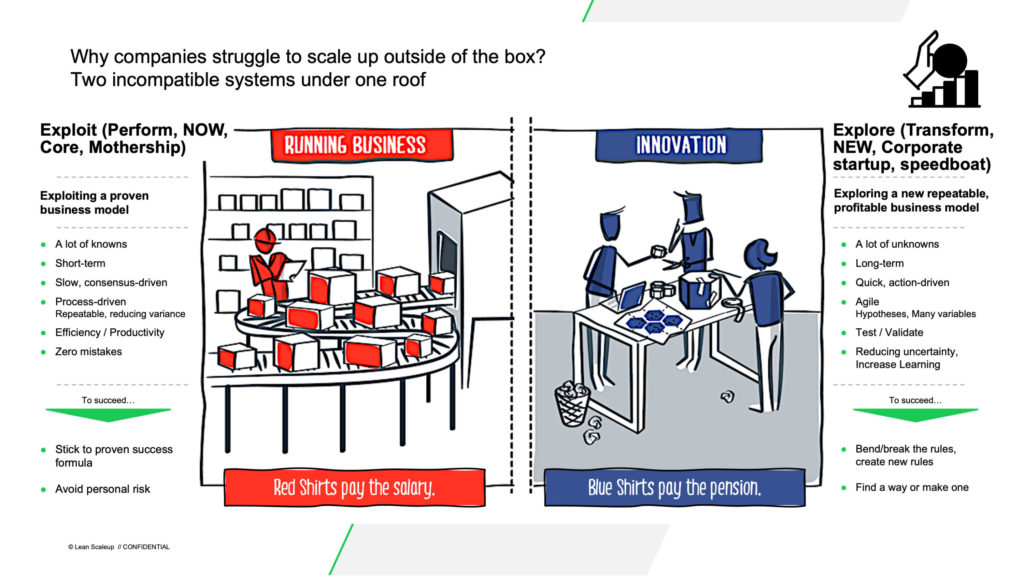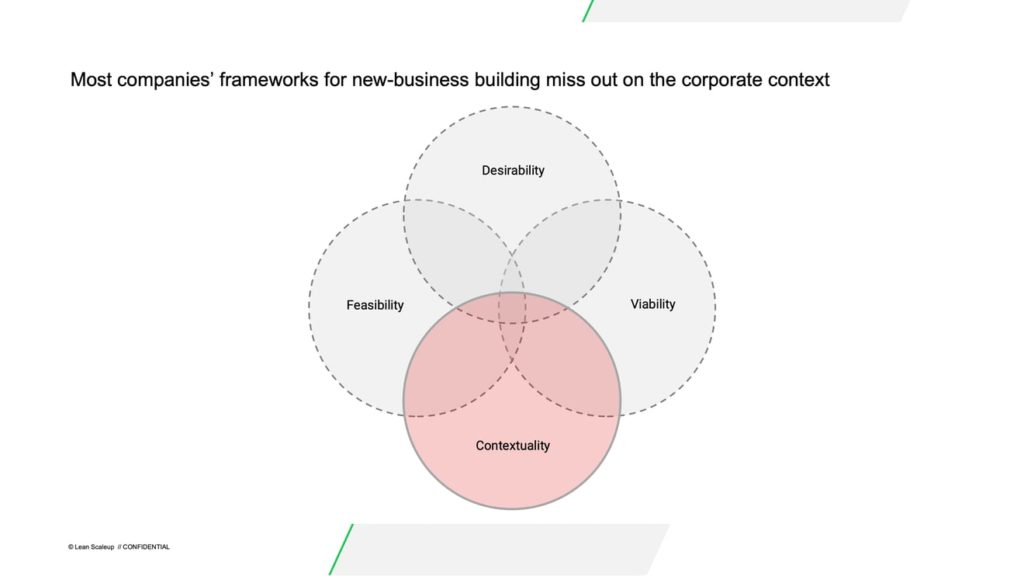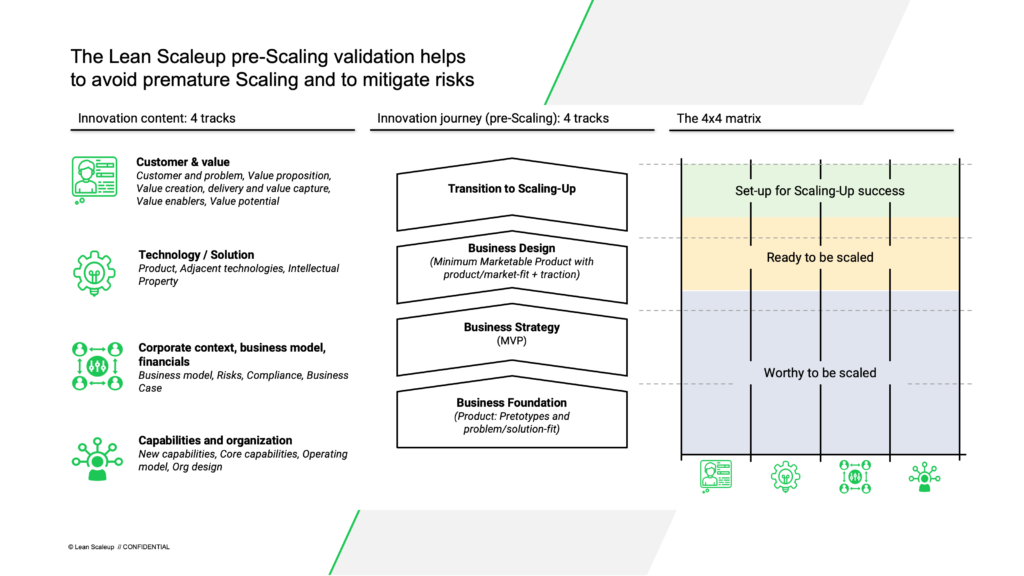This is the slightly edited version of an interview with Viima. The Spotify podcast is HERE, the YouTube video HERE (or below).
How did you arrive at the Lean Scaleup?
Viima: Could you share with us the story behind the story of the Lean Scaleup?
Frank: In essence, I’ve been working in a space that people nowadays like to call innovation for over 20 years. It all started when the term didn’t even exist. Back then, many companies called it ‘New Product Development.’
Around 10 years ago I got interested in the out-of-the-box space. Open Innovation was the hot topic of the day. I became interested in helping companies with finding solutions to technical problems.
Finally, around five years ago, a few of my clients, which are large global companies like bp, Bosch, or Telefonica, brought up a new problem. Their issue was not in the early stages, not in lacking ideas. They had more ideas than they could ever implement. But the problem was the neglible business impact that came out from their innovation activities. And they asked if there is any way I could help them with this.
That made me curious. I looked around and I found… nothing. Academia said that you have to split operations and innovation (ambidexterity). But it didn’t say how you bring things together at the end of the journey. Large consulting companies didn’t have a viewpoint on the topic either at that time.
So, I gathered 20+ companies, the London Business School, UC Berkeley and said that we need to stick our heads together – the wisdom of the crowd – to understand why is it so hard for companies to build new businesses inside of the existing business and how the solution could look like.
That’s where the whole journey started. One result was the framework that has been branded Lean Scaleup. But let me make this clear – that’s not Frank, it’s Frank moderating a process with brilliant minds from leading companies and leading business schools.
Which terminology do you find to be effective?
Viima: There are many different names for new business building, such as corporate venturing, entrepreneurship, corporate business building, and so on. How do you see this landscape and what kind of terminology do you use?
Frank: As you said, there are tons of definitions and the following are the ones that I use, but I am not claiming that these are the right ones.
For me, new-business building means bringing new business models to scale. New business models means that in the company’s Business Model Canvas some boxes are different. New customers, new channels, new value proposition, you name it. The the goal is implementing these elements and taking them to scale. This obviously implies that there is someone who is willing to pay for creating and scaling the new business model.
You also mentioned corporate venturing. I don’t like to use that term because it just sounds too similar to corporate venture capital and joint venture. I prefer to speak about corporate startups. It is when a company sees potential for a new business model and it decides to establish and fund a team and set this team on a mission to build this new business.
Finally, I use the term corporate venture. It’s when there is an external greenfield startup, backed with VC money, and the corporate commits to acquire a minority stake, say 5 percent to 25 percent. Some of these investmentments are just for hedging the bets. Others – and these are the ones that qualify – are made with the intention to make it big because they have got the assets and capabilities to do so. For instance, bp has a ‘Scaling-Up factory’ called bp Launchpad for such ventures.
Another piece of terminology is exploitation. It’s really important to understand where the problem comes from. Maybe we will touch upon this later on, but at the end of the day there are two systems under one corporate roof and you need both systems to future-proof the company.
The first system is the NOW system. Sometimes I also call it the Red Shirt system. 99 percent of the company’s staff work in this system. They run the day-to-day business, which is highly competitive and is a ‘Red Ocean’ , meaning the company battles with the usual suspects for the same customers using comparable value propositions and channels, and so on. And then there’s the second system – the innovators, the NEW system. They explore potential ‘Blue Oceans.’ They research and validate what could become in the future a significant, sizable business.

When is the right time to start new-business building?
Viima: When should a business look for opportunities inside to start new businesses and when to look for them outside?
When the business is a ‘burning platform’ it is usually too late. Think about Nokia vs Apple or Blockbuster vs Netflix. What I discovered is you need to do both. And there are success stories of that.
The prime example of a corporate startup is Amazon Web Services which as we speak right now is an USD 80 Billion [revenue generated in 2022] business. Obviously, that’s a huge success.
It started off when Amazon at the turn of the century recognized that their existing IT structure was not scalable, so they had to revamp and remodel everything. And they got the brilliant idea – why not have our customers pay for that IT transformation?
And if we look at the case of bp, one of the external greenfield startups that they took into bp Launchpad is Photek. Photek uses optical fibers to sense the environment, which could be applied for instance to monitor railway tracks or to monitor national borders, to sense if there are people trespassing. Photek is on its way to becoming a Unicorn. So success stories are everywhere.
What are the typical pain points?
Viima: What are the barriers that entrepreneurs face in established organizations?
Frank: It’s a system problem. 99% percent of the people work in the NOW system, in the day-to-day business. Their goals and bonuses are tied to flawlessly executing the past’s successful recipe, so to speak. They run processes and get their bonuses when they squeeze out 0.1% more productivity in a manufacturing process or gain 0.3% more customers. So they think in processes, 0 mistakes and short-term. And I don’t mean this in a disrespectful way.
Innovators come with different missions. They say that it’s good what the company has built in the past, but we are tasked with creating something new. And NEW always means that there is no standard, there’s no process.
So this is what I see as the brick wall that these innovators run in. It is the NEW System versus the NOW System. Here you can find a couple of, what I call, areas of tension. It’s about say the culture when Red Shirts say “you don’t belong to us.”
Let me give you just one example of this culture clash. Day-to-day business people are process-driven people, whereas innovators speak about experiments. But the people in NOW system do not do experiments. They run processes, which are repeatable, are predictable and set up for productivity.
Then there’s the organizational aspect. Let’s look at governance, for example. Many of the stakeholders who made their career in the Red Shirt world, run new-business building as if it was a part of the established business.
They assemble large committees, that bridge the silos as they are used to in the Red Shirt system. But this is not how you create new businesses.
You also need to make sure that you have the right capabilities in the governance board. maybe you want to add external experts in an advisory role. To illustrate, when you talk about AI these days, there are a handful of people who fully understand what’s going on. You cannot have a governance committee that is not firm on the topic that is being discussed – it simply does not work.
When I started to co-create the Lean Scaleup, one of the companies I worked with brought a brilliant insight to the table: The typical framework that companies use to create and validate new business models has three dimensions:
- Customers’ willingness to pay, which reflects the product or service’s desirability.
- The feasibility of making and industrializing the product or service.
- The business potential, focusing on profitability and margins to ensure its economic viability.
But here’s the big BUT: The whole corporate context in which new-business building unfolds is not represented in many companies’ frameworks. So it’s funny that we talk about corporate startups, corporate business building and corporate-whatever as we alluded to initially, but we do not see corporate represented in the new-business building frameworks that these companies use.

In the Lean Scaleup framework there is an additional fourth dimension that we called contextuality. It relates nicely from a language point with desirability, feasibility, and viability. Establishing that corporate context runs along the whole innovation journey. It starts with alignment and determining meaningful search fields for the company.
Then, you typically get thousands of ideas about what you could do in that space. But again, what is a meaningful idea relating to the company’s capabilities? Or what new capabilities must the company build? Then the corporate startup is charged with building those capabilities.
Then, how do you validate, in a corporate context? What I typically find in these situations is that all of the validation frameworks have a product-centric perspective. They talk about the Minimum Viable Product, about Product/market-fit, and so on. They don’t talk about building a business.
Then, finally, the corporate context shows up when you prepare the corporate startup for Scaling-Up. This is where the rubber meets the road, this is where the Red Shirts need to provide funding and resources, like access to customers, and prepare for reintegration further down the road. And only then are you in a position to scale up rapidly and with reduced risk.

So you see, it’s a comprehensive way of thinking. There’s a new level that the typical corporate frameworks do not represent, and that’s what you need to organize.
Luckily, now there is this framework, to my knowledge it’s the only one, or at least certainly the first one that has this contextuality layer built in.
How do you unblock a company that is stuck in its past success?
Viima: Organizations established decades ago, in my opinion, tend to be more resistant to change, as things they did years ago still work well today. Is that a wrong assumption and do you have some tips on how to approach this?
Frank: There are two systems, and each of those systems is right in its own way. The challenge is to make this one plus one equals three: running the day-to-day business, producing the margins needed to keep the stakeholders and the shareholders happy, at the same time, funding the search for tomorrow’s businesses and provide a superior value proposition for the customers.
In my view, culture is an artifact that reflects everything happening within a company, how the company sees its mission, defines the degrees of freedom for individuals, determines what behaviours are rewarded or penalized, and much more.
But you are perfectly right, in order to solve the system problem between today’s business and tomorrow’s business, you need to have a system solution.
And this system solution has three parts:
• First, it’s leadership – balancing NOW and NEW.
• Looking at the process from the right perspective.
• And finally – and here we are, it’s culture, people, and collaboration.
In order to solve a system problem, you need a system solution made up of three parts: dual leadership, the right process, and the balance between culture – people – collaboration. These three elements need to be congruent in the overall setting.
How do you spot innovation theater?
Viima: How do you determine whether a corporate startup is a value-generating opportunity instead or an innovation theater?
Frank: It’s the art of validating and the art of killing in the corporate context. A typical Red Shirt senior manager would say well, we launch a project focused on a new business building. They would set up a large governance board, secure funding, they would nominate a dedicated individual, pat them on the shoulder and say “you are building the future, good luck”.
That’s not how you run new-business building.
You have to run experiment after experiment, and you have to build these experiments into a solid validation framework.
This framework should validate the customer side, product, tech, IP, corporate context, and capability. All at the same time.
You also need to be transparent here and admit “hey, we did not achieve the expected key results from the customer side and it is time to kill this one start-up, but the good news is we’ve got seven other ideas from it that we are testing and validating”. So it’s about the entrepreneurial mindset, it’s about taking – as Jeff Bezos would tell us – small, rapid, and effective experiments and then letting the data speak.
What are the key takeaways?
Viima: If you were able to pick one message that you would like our listeners to take from this conversation what it would be?
Frank: Companies need to build new businesses, but the world outside is volatile, it’s unshaped, it’s complex, it’s dynamic, it’s ambiguous. If you look at the statistics, only 3% of the attempts to build new businesses will win, which means that 29 out of 30 fail.
The reason for that is that we have a system problem – there’s today’s business and there’s tomorrow’s business.
And how do you solve that, how do you bridge and connect these systems, so that you would future-proof the company, today and tomorrow?
It turns out that you need to work on three levels: the leadership level, the process level, and the people/culture/collaboration level. And there is a framework for that. It takes the good things from the lean startup, but it makes it broader and extends it to the corporate context. Lastly, it extends the duration as it considers the end-to-end journey.
Tell us more about the upcoming book.
Viima: When can we expect the revised, third book to be published?
We’re currently co-creating the book with more than 100 practitioners and half a dozen of business schools.
So if some of the readers are interested in joining the process please – ping me by clicking on the pop-up.
I am expecting the book to be finished after the summer break, sometime in September or October 2023.
